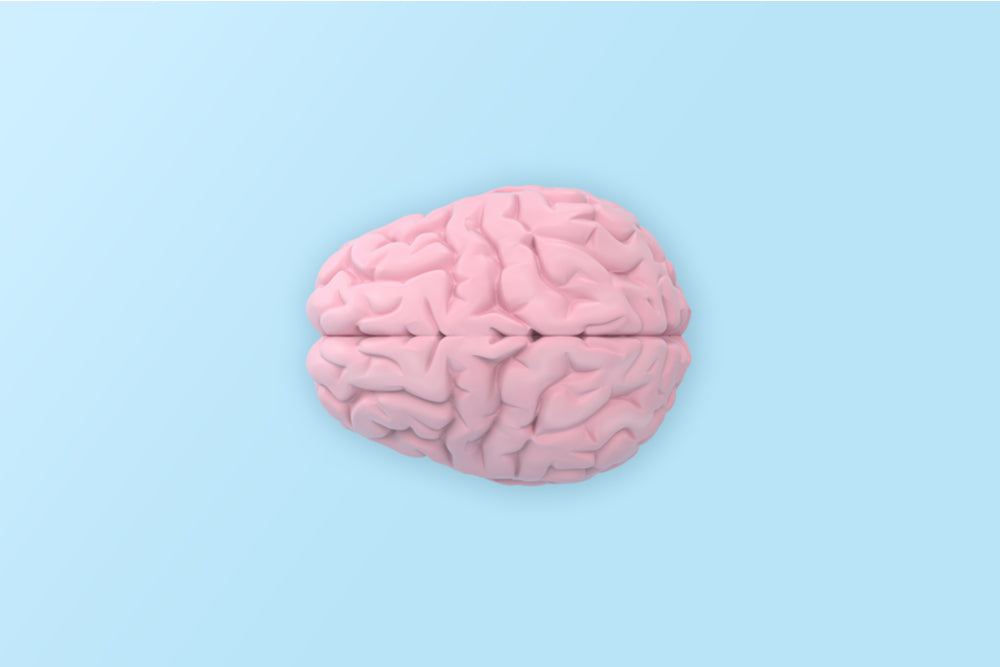Despite its remarkably small, seemingly inconspicuous size, the pituitary gland produces a number of hormones and has incredible importance for a huge range of vital bodily functions.
There’s a reason why the pituitary is known as the ‘master gland’. For your brain function, vision, mood, growth, energy, reproduction and much more, this pea-sized, bean-shaped gland plays a key role.
The pituitary gland can also have significance for the menopause, a time of particular hormonal upheaval for women. Ovarian changes cause the pituitary to produce higher levels of follicle-stimulating hormone, resulting in hot flushes — perhaps the quintessential menopause symptom! Let’s take an in-depth look at this extraordinary organ.
What is the pituitary, how does it work, what hormones does it produce and how is it involved in the menopause transition?
What is the pituitary gland?
Your pituitary gland (hypophysis) is a pea-sized organ that sits at the base of the brain, between the ears and behind the nose. It produces hormones that affect a wide range of vital bodily functions and processes, including reproduction, metabolism, growth, blood pressure, mood and more. Known as the ‘master gland’, it also controls the function of most other endocrine glands.
The pituitary is one of eight major endocrine glands within the human body, together forming the endocrine system. Each is interrelated, but as well as secreting its own hormones, the pituitary gland instructs other glands to produce hormones.

To be more scientific and specific about the pituitary gland’s location, it sits within the sella turcica — an indent in the sphenoid bone, which is situated in the middle of the skull, forming part of the neurocranium.
The pituitary gland has two sections: the front (anterior) lobe, and the back (posterior) lobe. It is connected to the hypothalamus by a stalk of nerves and blood vessels.
What does the pituitary gland do?
The pituitary produces and secretes a range of hormones that are absolutely essential to a number of bodily functions and processes. These hormones target a certain organ or tissue in the body. The pituitary gland also tells other glands — target glands — to produce hormones.
The pituitary is largely controlled by a part of the brain called the hypothalamus, to which it is connected. The hypothalamus detects levels of hormones being produced by the pituitary’s target glands, with the hypothalamus and pituitary deciding how much these glands need to be stimulated.
The hypothalamus communicates with the pituitary’s front lobe through hormones travelling in the bloodstream, and the pituitary’s back lobe via nerve impulses.
This partnership helps to control many of our body’s basic operations, sending messages through our nervous system to moderate our blood pressure, heart rate, sleep-wake cycle, digestion, respiration, body temperature and more.
What are the major hormones produced by the pituitary gland?
The pituitary creates a number of crucial hormones, including adrenocorticotropic hormone (ACTH), thyroid-stimulating hormone (TSH), follicle-stimulating hormone (FSH), growth hormone (GH) and more. These hormones affect different parts of the body, including our reproductive organs, muscles, bones, brain, kidneys, skin and mammary glands.
Rather than a steady, consistent stream, most of these hormones are secreted in bursts every few hours in accordance with our body’s requirements. Some — like growth hormone, prolactin and ACTH — rise and fall during the day, peaking as we wake up and falling to their lowest levels before going to sleep. Others, which affect reproductive function, fluctuate during the menstrual cycle.
The anterior and posterior pituitary gland are responsible for secreting certain types of hormones into the bloodstream. Hormones released by the posterior pituitary are only stored there, after having been created in the hypothalamus.
Hormones produced by the anterior pituitary gland and their target include:
- Adrenocorticotropic hormone (ACTH) — targets the adrenal glands. It regulates the production of the stress hormone cortisol, which itself is responsible for maintaining blood sugar and blood pressure levels.
- Endorphins — targets the brain and immune system. These neurotransmitters help to relieve stress and pain, as well as make us feel happy.
- Enkephalins — targets the brain. These neurotransmitters play a key role in brain function: emotional behaviour, learning, memory and pain.
- Follicle-stimulating hormone (FSH) — targets the ovary or testes. In women, it stimulates the ovaries to create oestrogen; in men, this hormone promotes sperm production.
- Growth hormone (GH) — targets muscle and bones. As its name suggests, this pituitary-secreted hormone is responsible for maintaining healthy muscles and bones, as well as managing fat distribution.
- Luteinising hormone (LH) — targets the ovary or testes. In women, this hormone stimulates ovulation. In men, it promotes testosterone production.
- Prolactin (PRL) — targets the mammary glands. After childbirth, this hormone causes breast milk to be produced. Prolactin hormone also interacts with other hormones that have a role in fertility, sexual function and menstrual periods.
- Thyroid-stimulating hormone (TSH) — targets the thyroid gland. As the name succinctly suggests, this hormone prompts the thyroid to produce its own hormones, responsible for our metabolism and energy levels.
Hormones produced by the hypothalamus and then stored in the posterior pituitary, before being secreted by the gland include:
- Antidiuretic hormone (ADH) — targets the kidneys. Also known as arginine vasopressin (AVP), this hormone regulates our sodium levels and the amount of water released by the kidney. It is crucial for maintaining water balance in the body.
- Oxytocin — targets the uterus and mammary glands. This hormone is crucial to different stages of the labour process. Oxytocin helps breast milk to flow and plays a role in behaviour and bonding between a child and its mother.
There’s also the intermediary pituitary gland. This is responsible for producing and secreting one other type of hormone, MSH.
- Melanocyte-stimulating hormone (MSH) — this stimulates the production of melanin by melanocytes in the skin. Melanin provides pigmentation and protection for the skin against the sun’s UV light.

When your pituitary isn’t functioning properly — either it’s overproducing hormone (hyperpituitarism) or underproducing hormone (hypopituitarism) — many bodily functions and processes can be negatively affected: your growth, vision, skin, mood, energy, reproductive functioning, blood pressure and more.
If you believe you may have a problem pointing towards your pituitary gland, make sure to get in touch with a medical professional as soon as possible.
The menopause process: the role of the pituitary gland & its hormones
As we approach menopause, there is an age-related decline in follicle numbers in the ovary. This causes falling levels of inhibin which, in turn, results in an increase in follicle-stimulating hormone (FSH) by the pituitary gland. FSH causes ovarian follicles to enlarge and produce oestrogen. With fewer follicles to stimulate and less oestrogen being produced, the pituitary compensates by creating more FSH.
The hormonal changes that take place during the menopause can be drastic and marked. As well as increased levels of FSH, ovarian changes also cause the pituitary gland to secrete higher levels of luteinising hormone (LH), another key reproductive hormone.
Follicle-stimulating hormone (FSH) levels and measuring menopause status
Because the pituitary produces more FSH in response to ovarian follicle changes, a high level of FSH is sometimes used as an indicator of the menopause. However, since levels of oestrogen and FSH can fluctuate throughout the menopause — even from day to day — FSH readings by themselves are not normally considered enough to be absolutely sure that you’re menopausal.
Instead, FSH levels are usually used alongside other measures to confirm menopause status. A doctor will be able to test your FSH levels with a simple blood test.
An FSH hormone level greater than 30 mIU/mL indicates that a woman is undergoing the transition towards the menopause — also known as the perimenopause. A reading in the region of 70–90 mIU/mL is often seen in postmenopausal women.
Because the pituitary secretes more luteinising hormone in response to an oestrogen deficiency, raised levels of this reproductive hormone can also be used as an indicator of menopausal status.
For between two to eight years after your final period, FSH levels remain stable. Thereafter, they begin to fall. By age 75, both FSH and LH have declined by approximately 30%.
The pituitary gland and menopause symptoms
During the menopause, ovarian changes and oestrogen deficiency cause the pituitary gland’s production of FSH to remain ‘on’. Raised FSH levels coupled with lower oestrogen levels are what causes hot flushes, undoubtedly the most commonly-reported, classic menopause symptom.
After the menopause, levels of FSH remain relatively stable for a few years, during which time you may still continue to experience hot flushes. Because high FSH levels go hand-in-hand with low oestrogen levels, they are associated with other hallmark menopause symptoms like infertility, irregular periods and sleeping problems.
Going through the menopause is not the exclusive cause of high FSH levels; other hormonal problems like polycystic ovarian syndrome (PCOS) and primary ovarian insufficiency can be at the heart of a problem. If you think you have symptoms pointing to your FSH levels, be sure to get in touch with your doctor.
Inspired Health: for wellness & menopause healthy living
We’re the official UK home for a number of leading health and wellness brands. This includes Cleanmarine and their leading MenoMin daily supplement, specially formulated for perimenopausal and menopausal women.
For more insights, check out The Menopause Blog — a carefully-curated hub of research-packed content relating to the menopause. For general health and wellbeing information, be sure to also explore our Wellness blog.









